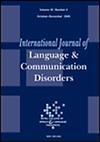Sentence Comprehension and L2 Exposure Effects in 6-Year-Old Sequentially Bilingual Children With Typical Development and Developmental Language Disorder
Abstract
Background
Differentiating typical language development (TD) and developmental language disorder (DLD) in a bilingual context is difficult. The societal language is often the only mutual language of the child and the SLT. It has been shown that when assessing second language (L2) performance using tools developed for monolingual children, substantial differences between typical and disordered development can be found. There is a need for a systematic understanding of the applicability of tests across different language domains, taking language exposure into account. Sentence comprehension is an important part of language development, and receptive difficulties have often been considered to have prognostic value. Yet, the diagnostic value of sentence comprehension has received little research attention.
Aim
In the Helsinki longitudinal SLI study (HelSLI), we investigated L2 exposure effects on sentence comprehension in sequentially bilingual typically developing children (BiTD) and bilingual children with DLD (BiDLD). In addition to group-level comparisons, we examined the classification accuracy of two L2 sentence comprehension tests, taking several explanatory factors into account.
Methods and Procedures
A total of 100 six-year-old children were recruited from day care centres and a hospital clinic (54 BiTD children and 46 bilingual children with DLD). Two offline tests with multiple-choice and act-out tasks (Sentence Comprehension Test (Lausetesti) and Reynell Developmental Language Scales III, Verbal Comprehension Scale) were used to investigate sentence-level comprehension in Finnish. Multiple regression analysis was used to compare BiTD and BiDLD group performance while considering the effects of relative lifetime exposure to L2. Covariate-specific receiver operating characteristic (ROC) analysis was used to study the classification accuracy of the two tests and estimate the thresholds for optimal sensitivity and specificity of the tests.
Outcomes and Results
The TD bilingual children performed significantly better than their peers with DLD in both sentence comprehension tests. The effect of L2 exposure was significant but small and affected both groups similarly. Both tests classified the groups with fair sensitivity and specificity at their best, but the accuracy depended greatly on exposure. Depending on the age and exposure to L2, a sensitivity of 0.80 yielded a specificity of 0.16–0.87 on the Sentence Comprehension Test and a specificity of 0.19–0.87 on the RDLS III Verbal Comprehension Scale.
Conclusions and Implications
Sentence comprehension in L2 is promising in informing the detection of language difficulties in L2 Finnish learners with several first-language backgrounds. However, interpretation must take L2 exposure into account. In addition, no one assessment tool or domain can be considered enough for the identification of DLD. In the future, the importance of sentence comprehension tests as classifiers should be considered as part of a larger assessment battery.
WHAT THIS PAPER ADDS
- Differentiating developmental language disorder (DLD) from typical language development (TD) is difficult in bilingual children. Assessment tools are needed for more reliable detection of disordered development. It has been shown that assessing both languages in bilingual children adds to the classification accuracy. The societal language is, however, often the only mutual language between the SLT and the child, and the only available tests are frequently in the child's L2. It has been found that substantial differences in second language (L2) performance between bilingual typically developing children (BiTD) and bilingual children with DLD (BiDLD) groups can be found in different language domains. Language exposure effects in BiTD and BiDLD children as well as classification accuracy of the L2 tests vary, however.
- L2 sentence comprehension has received little attention in the field of communication disorders. In the current study, sentence comprehension tests showed substantial differences in L2 performance between bilingual TD and DLD children. On a group level, the effect of L2 exposure was small relative to some other language domains and appeared similar in BiTD and BiDLD children. Classification accuracy, however, depended greatly on exposure. In addition, it was found that some tests classify the children with more exposure better and some those with less exposure. Such patterns are related to the difficulty of the test items and the age range targeted by each test.
- Sentence comprehension is a promising language domain informing the identification of DLD in bilingual children with different L1 backgrounds. Even though the BiTD and BiDLD groups differ significantly in their test performance, it is advisable to consider the possible differences in sensitivity and specificity of the test depending on exposure. In the domain of sentence comprehension, despite the persistent difference in performance between BiTD and BiDLD children, DLD children seem to be able to benefit from the exposure in a similar manner as TD children instead of lagging behind in the course of accumulating exposure.


 求助内容:
求助内容: 应助结果提醒方式:
应助结果提醒方式:


